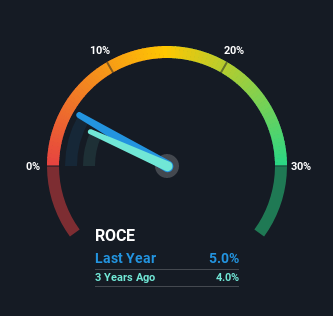- Hong Kong
- /
- Infrastructure
- /
- SEHK:3382
Be Wary Of Tianjin Port Development Holdings (HKG:3382) And Its Returns On Capital
When we're researching a company, it's sometimes hard to find the warning signs, but there are some financial metrics that can help spot trouble early. Typically, we'll see the trend of both return on capital employed (ROCE) declining and this usually coincides with a decreasing amount of capital employed. Trends like this ultimately mean the business is reducing its investments and also earning less on what it has invested. So after we looked into Tianjin Port Development Holdings (HKG:3382), the trends above didn't look too great.
Return On Capital Employed (ROCE): What is it?
Just to clarify if you're unsure, ROCE is a metric for evaluating how much pre-tax income (in percentage terms) a company earns on the capital invested in its business. The formula for this calculation on Tianjin Port Development Holdings is:
Return on Capital Employed = Earnings Before Interest and Tax (EBIT) ÷ (Total Assets - Current Liabilities)
0.05 = HK$1.9b ÷ (HK$48b - HK$11b) (Based on the trailing twelve months to June 2021).
So, Tianjin Port Development Holdings has an ROCE of 5.0%. Ultimately, that's a low return and it under-performs the Infrastructure industry average of 8.3%.
See our latest analysis for Tianjin Port Development Holdings

Historical performance is a great place to start when researching a stock so above you can see the gauge for Tianjin Port Development Holdings' ROCE against it's prior returns. If you'd like to look at how Tianjin Port Development Holdings has performed in the past in other metrics, you can view this free graph of past earnings, revenue and cash flow.
The Trend Of ROCE
There is reason to be cautious about Tianjin Port Development Holdings, given the returns are trending downwards. Unfortunately the returns on capital have diminished from the 7.0% that they were earning five years ago. Meanwhile, capital employed in the business has stayed roughly the flat over the period. Companies that exhibit these attributes tend to not be shrinking, but they can be mature and facing pressure on their margins from competition. If these trends continue, we wouldn't expect Tianjin Port Development Holdings to turn into a multi-bagger.
What We Can Learn From Tianjin Port Development Holdings' ROCE
All in all, the lower returns from the same amount of capital employed aren't exactly signs of a compounding machine. It should come as no surprise then that the stock has fallen 51% over the last five years, so it looks like investors are recognizing these changes. With underlying trends that aren't great in these areas, we'd consider looking elsewhere.
Since virtually every company faces some risks, it's worth knowing what they are, and we've spotted 2 warning signs for Tianjin Port Development Holdings (of which 1 doesn't sit too well with us!) that you should know about.
If you want to search for solid companies with great earnings, check out this free list of companies with good balance sheets and impressive returns on equity.
Valuation is complex, but we're here to simplify it.
Discover if Tianjin Port Development Holdings might be undervalued or overvalued with our detailed analysis, featuring fair value estimates, potential risks, dividends, insider trades, and its financial condition.
Access Free AnalysisHave feedback on this article? Concerned about the content? Get in touch with us directly. Alternatively, email editorial-team (at) simplywallst.com.
This article by Simply Wall St is general in nature. We provide commentary based on historical data and analyst forecasts only using an unbiased methodology and our articles are not intended to be financial advice. It does not constitute a recommendation to buy or sell any stock, and does not take account of your objectives, or your financial situation. We aim to bring you long-term focused analysis driven by fundamental data. Note that our analysis may not factor in the latest price-sensitive company announcements or qualitative material. Simply Wall St has no position in any stocks mentioned.
About SEHK:3382
Tianjin Port Development Holdings
An investment holding company, operates the port of Tianjin in the People’s Republic of China.
Flawless balance sheet and good value.
Similar Companies
Market Insights
Community Narratives



